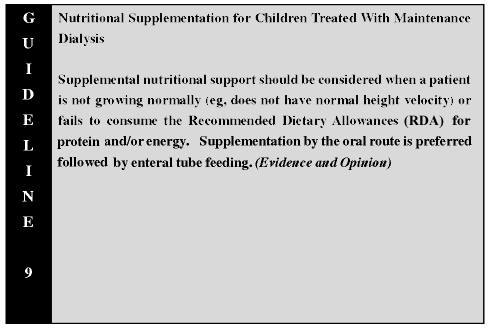

Poor oral intake is common in children undergoing chronic dialysis. The reasons behind the inadequate intake are multifactorial. Metabolic derangements and medications may affect taste, appetite, and gastrointestinal function.15 Abdominal fullness from the peritoneal dialysate solutions may result in the active refusal of food. Gastroesophageal reflux is particularly common in infants and may further impair feeding activity.54
During infancy, oral supplementation can be achieved by increasing the caloric density of the formula using modular components of carbohydrate, fat, and protein.32;55 In older children and adolescents, energy and protein supplementation can be accomplished using modular components or using commercial enteral products in liquid or bar form.
Enteral tube feeding should be considered in those who are unable to meet nutritional goals by the oral route alone. Nasogastric or gastrostomy tube or button and gastrojejunostomy tubes have all been used successfully to provide additional formula or oral supplements by intermittent bolus or continuous infusion. Each has associated advantages and disadvantages.56-58 The nasogastric tube has been used most frequently in infants and young children, is easily inserted, and is generally well tolerated.56 The use of this route of therapy is not aesthetically pleasing, however, and is often complicated by recurrent emesis and the need for frequent tube replacement. The gastrostomy tube or button is hidden beneath clothing and can be used within days of placement, even in the patient receiving peritoneal dialysis.58;59 Reported complications associated with nasogastric and gastrostomy tubes or button feeding include emesis, exit-site infection, leakage, and peritonitis.60 Gastrojejunostomy feeding should be considered in the child receiving enteral tube feeding when gastroesophageal reflux is severe and not amenable to medical therapy. Surgical repair of gastroesophageal reflux may also be considered in this situation.
A prolonged and potentially difficult transition from tube to oral feeding can occur in infants who use any form of enteral tube feeding.61;62 Regular non-nutritive sucking and repetitive oral stimulation are recommended for all tube-fed infants. A multidisciplinary feeding team (eg, dietitian, occupational therapist, or behavioral psychologist) may be needed to facilitate the transition from tube to oral feeding.
To date, intraperitoneal nutrition with the use of dialysate solutions substituting amino acids as an alternative to glucose has been evaluated in only a limited number of children receiving peritoneal dialysis and has been used in individual patients for periods of time that do not exceed 6 to 12 months.63-65 The quantity of amino acids absorbed from the dialysate routinely exceeds the protein lost in the dialysate. Future studies may prove this route of nutritional supplementation to be a valuable adjunct to the oral and enteral routes of therapy.